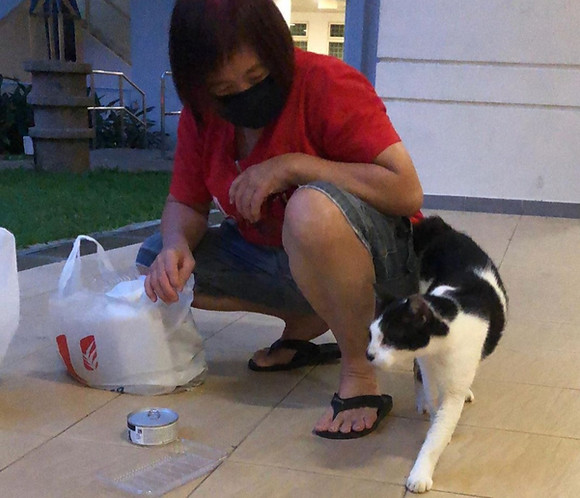
Feeding of strays cause strifes in communities
By Sasha Ling & Khoo Sin Yee
Conflicts arise between community cat feeders and neighbours who are concerned about the cleanliness of the community. SASHA LING and KHOO SIN YEE find out more.

The act of feeding of community cats has become a norm here in Singapore. Photo courtesy of @straycatsof_sg on Instagram.
Neighbourhood cats, which are often found near HDB flats, are tearing communities apart.
Ms Jasmin Kuan, 48, a cat feeder, is no stranger to unpleasant encounters with her neighbours.
“A lot of people have threatened to call the Animal & Veterinary Service (AVS) to cull the stray cats in their area so they will not see feeders,” she says over an email interview.
Ms Andrea Seah, 18, a student, is one who disagrees with the feeding of strays: “Frankly, there would be [an] overpopulation of stray cats.”
“Furthermore, feeding them does not equate to giving proper care. The cats may even be too reliant on humans for food and lose its ability to hunt,” Ms Seah adds.
Cat food left uncleared by irresponsible cat feeders may attract pests which can endanger public health. The stagnant water left for the cats also provides breeding grounds for mosquitoes.
Ms Tan Ee Rong, education officer at the Society for the Prevention of Cruelty to Animals (SPCA), acknowledges these concerns: “I understand why the feeders left food and water out for the cats, but because of that it attracts pests such as cockroaches, rats, birds, ants, and more.”
Although feeding strays is not illegal in Singapore, Town Councils often put up posters discouraging the feeding of strays in neighbourhoods. “There’s this act of discouraging the feeding of strays, but I can also understand that it’s due to concerns for the issue [of cleanliness],” says Ms Jasmine Foo, a volunteer at The Sand Fund, an organisation that cares for community cats.
Ms Tan disagrees: “I don’t think that it should be discouraged. It is great to see that the residents are so empathetic towards these community cats, and [are] coming together to care for the cats.”

Community cats have become synonymous with the Singaporean identity. They are most commonly spotted in void decks, parking lots and parks. Photo courtesy of @straycatsof_sg on Instagram.
To maintain the cleanliness of the community, there are regulations put in place for feeding stray cats. Some of these regulations include feeding within a 2-hour window and only feeding the cats on the ground floor at an area with minimal human traffic. Leaving cat food on the ground without clearing up will be considered as littering and is thus illegal.
From 2015 to 2017, the National Environment Agency (NEA) received about 1,600 cases of feedback on the feeding of stray cats. In all cases except for two, the cat feeders were compliant in clearing any leftover food within two hours.
Ms Foo says: “Feeders now use plastic sheets, or cups and plates to place the food on it, and they will clean up after feeding. When they notice there’s leftover food or a mess after feeding they will remind each other to remember to clean up after the cat.”
Ms Kuan thinks that the conflict between cat feeders and their neighbours is due to a misunderstanding. “I think a small number of irresponsible feeders has caused a bad impression of stray feeding to the general public… As a result, the general public sees stray cat feeders as a nuisance in view of these bad publicity,” she says.

Community cat, Dot, is regularly fed by citizens in the Compassvale neighbourhood. Photo courtesy of The Sand Fund.
Ms Foo thinks that the awareness of responsible feeding practices needs to be passed onto the older generation of feeders. “[For] feeders who are unaware, they might be old aunties and uncles [who] don’t use social media, that’s why they are not aware of the issue,” she says.
“I think that there is still some space for education [of responsible feeding practices], to spread this awareness and remind other feeders about it,” adds Ms Foo.
Ms Tan suggests that posters be placed in neighbourhoods to inform the feeders who might be unaware of feeding regulations, as “some kind Samaritans might feed these cats once or twice but [they] don’t know about the feeding time and end up leaving the food out, [which] attracts pests”.
However, the root of the problem may lie in the abandonment of pet cats. In 2019, the number of cat abandonment cases reached a record high, according to a report by the Cat Welfare Society (CWS).
Ms Kuan says: “Can we discourage pet abandonment? Can we encourage criminal law against backyard breeding and fines for not sterilizing pet cats?”
“If there are no stray cats, why would there be a need for stray cat feeders?”
